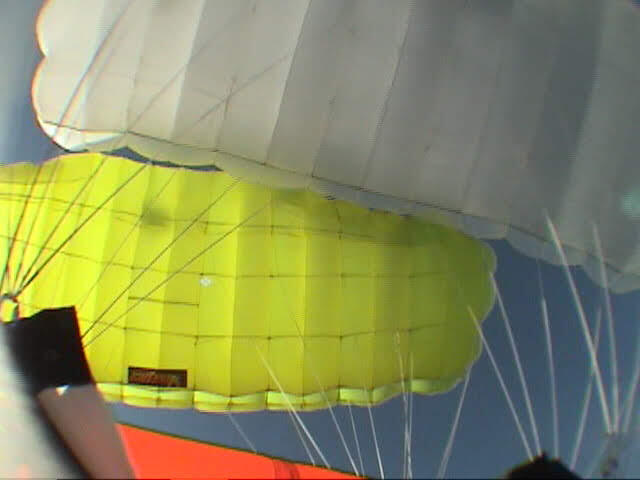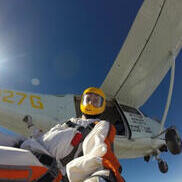-
Content
214 -
Joined
-
Last visited
-
Feedback
0%
Content Type
Profiles
Forums
Calendar
Dropzones
Gear
Articles
Fatalities
Stolen
Indoor
Help
Downloads
Gallery
Blogs
Store
Videos
Classifieds
Everything posted by SkydiveMO
-
I was jumping at a DZ that implemented a no hook-turn policy some years ago. Many of the jumpers were unhappy with the change and a few even left the DZ, but in the end things quieted down and… well nobody hook-turned anymore. Say what you may the DZ had the lowest injury rate in the area. DZOs are running a business and someone pounding in under canopy is just bad for business.
-
I find mine fits nicely on my chest strap; I turn it sideways so it runs along the chest strap.
-
All the canopies you are considering are great choices. As for which is better, that depends on your canopy flight preferences. 7-cells have steeper glide paths then 9-cells, simply put they sink faster. In my experience this allows you to hold closer to your target and be more accurate on landing. However, if you plan on loading your canopy over a 1:1 ratio I’d suggest the 9-cell. 9-cells can be far more forgiving on landing with much greater flare. When I bought my 7-cell I was loading it at 1.1:1 and it landed real nice. Then I left the Army for college, needless to say I quickly gained a natural arch and the flare went right out of my canopy. I know its been said before but you can’t hear it enough demo several canopies and see what fits your flight style. I think the best advice for a first rig is… Buy used… Buy big… If you plan on making skydiving a fulltime hobby there will always be time to down size your gear later.
-
ParaMount’s SuperLite camera helmet is a well-built, very light and affordable camera platform. It is perfect for the jumper on a tight budget or who isn’t interested in all the bells-n-whistles offered by other more expensive helmets. I have made over 200 video jumps using the SuperLite with both video and stills for RW, Freeflying, AFF and Tandem jumps. The Pros: Great price – This is the reason I chose the Paramount as my first camera helmet. It actually cost only slightly more then making my own camera helmet from an old Pro-tec. Very Stable – The SuperLite uses a locking band and chin cup to secure the helmet. In freefall the helmet remains firmly secured with no sliding or slipping. Just a side note, swapping the provided soft chin cup with a hard plastic cup used for football helmets makes a big difference in comfort. Lightest dual camera system – Use a lightweight video and still camera with this system and your neck will thank you. Open to the air - The open design of the helmet makes it very comfortable in the summer. The Cons: BRAIN VICE – The locking mechanism used by the SuperLite is a brain vice and will squeeze you senseless. If loosened for comfort the helmet slides around in freefall giving unwanted shudder or movement to the video. This is my only complaint about the SuperLite and my caution to anyone looking to start any serious videography. If you plan on making several jumps a day with this helmet be warned. You can minimize your discomfort by locking the helmet shortly before exiting and unlocking it while under canopy. Easy to bump sight – You must lay the helmet on its side to avoid bumping the sight. Several of the videographers at my DZ used mannequin heads to set their cameras on while dubbing videos. Open to the air - In the cold there is no protection from the wind. I used a balaclava in the winter and had no problems keeping warm. Top-mount video only – The system will not allow you to side-mount a video or still camera. ParaMount’s SuperLite helmet is an excellent product at an excellent price. I would suggest it for anyone looking for a starter helmet. At such a low price I was able to quickly turn the money I made from videos into profit. I later used that money to purchase a more expensive but more comfortable helmet.
-
I recently went through the same process of picking a laptop for video editing at the DZ. After looking over all the options I chose the PowerBook G4 from Macintosh. The combination of processing power, DVD burning and Final Cut Express software sold me on the system. I have used my new toy for about 4 months now so I can give some of the pros and cons of my decision. Pros- -The Final Cut Express software allows me to edit video in any manner of my choosing. I am only limited by my imagination (and hard drive space) -The Macintosh operating system has been very stable and I have had very little difficulty switching from a Windows machine -I haven’t found a digital video camera at the DZ I can’t plug a firewire cable into and pull video from without any downloads or updates -DVD burning is easy and the format used has worked with every DVD player I’ve tested it with Cons- -You need an additional device to pull video from TV, VCRs, Non-digital Cameras, etc. Basically any non-firewire or USB device. A feature offered by the Sony Vaio -Special software required if you plan to run any Microsoft software -Laptops have smaller hard drives then tower or desktop units. This is readily apparent if you do a lot of video work or plan on archiving videos. I’m currently looking at external hard drives to solve this problem. I have been very happy with my selection and would still choose the PowerBook over the Sony Vaio. However, every time I’m in the computer store I look at the Sony Vaio and wish I could afford a second laptop. The Vaio is a well-rounded computer, and if you are using a Sony camera you know the two will work together seamlessly. Whichever system you choose I suggest splurging on the upgraded hard drive, RAM and processor. Video editing really chews up the computers resources and you’ll quickly regret buying the base system.
-
People psycho pack simply because it is easier to control a slick ZP canopy when it’s rolled then when it’s s-folded. Some jumpers feel it is an unsafe packing method, though I have never heard a good explanation of why. I have psycho packed my Triathlon 160 and a Stiletto 150 for years, I have always had soft on heading openings. If you decide to try packing your canopy using this method just ask an instructor or rigger to watch you the first time or two. Stay safe, use the knowledge at your DZ to your advantage.
-
I would definitely agree that canopies do not always scale well. I assisted the Parks College Parachute Research Group www.pcprg.com with various testing of scaled models of military canopies and we found radical changes in performance with changes in scale. Parachutes are very dynamic; I can see how PD may have run into some unexpected surprises at certain canopy sizes.
-
My only question is… Does the guy who recovers the Main and Freebag get the beer?
-
I have been in contact with PD and tried to finagle a tentative release date out of them. The best response I could get was the Katana “will be available for the upcoming US skydiving season”. I’m sure their doing their best to release a safe and reliable canopy, I just wish they could give us a little more info on what to expect and where they stand in development.
-
While I’m all for comprehensive testing of a canopy before it’s release, (lost half a tooth to a hard opening on a competitors design that had been released prior to proper testing) you have to wonder what good can come from keeping us in the dark about the Katana’s release date. With their website PD could post updates on their progress, even if they are unable to feed us an exact release date. A general idea of the progress they’re making on the project would be appreciated. I’m in the market for a new elliptical and would be willing to wait for a PD product, as their experience in the market is unquestionable. However, the Crossfire2 has been out and I have heard few complaints about its performance and reliability. PD has our attention, and my interest, but they must remember we are skydivers… We do have short attention spans.


